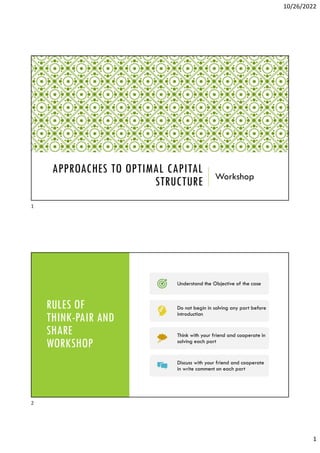
Optimal Capital structure Lecture notes.pdf
- 1. 10/26/2022 1 APPROACHES TO OPTIMAL CAPITAL STRUCTURE Workshop RULES OF THINK-PAIR AND SHARE WORKSHOP Understand the Objective of the case Do not begin in solving any part before introduction Think with your friend and cooperate in solving each part Discuss with your friend and cooperate in write comment on each part 1 2
- 2. 10/26/2022 2 OPTIMAL CAPITAL STRUCTURE – CASE STUDY A firm is contemplating changing the capital structure of the firm. Basic Data All-Equity Capital Structure The firm has EGP45,000,000 in total assets, 1. Debt = Debt ratio*total Assets 2. Equity = Total Assets – Debt 3. # of Shares outstanding = Equity/20 4. # of shares repurchased = debt/20 %debt Total Assets Debt ($) Equity ($) Number of Shares @20 0% 45,000,000 10% 20% 30% 40% 50% 60% a. Complete the following table showing: 1. the values of debt, 2. equity, 3. the total number of shares of common stock. The book value is $20 per share. 3 4
- 3. 10/26/2022 3 WHAT YOU OBSERVE? %debt Total Assets Debt ($) Equity ($) Number of Shares @20 # of shares Repurchased 0% 45,000,000 - 45,000,000 2,250,000 - 10% 45,000,000 4,500,000 40,500,000 2,025,000 225,000 20% 45,000,000 9,000,000 36,000,000 1,800,000 450,000 30% 45,000,000 13,500,000 31,500,000 1,575,000 675,000 40% 45,000,000 18,000,000 27,000,000 1,350,000 900,000 50% 45,000,000 22,500,000 22,500,000 1,125,000 1,125,000 60% 45,000,000 27,000,000 18,000,000 900,000 1,350,000 COMPLETE THE FOLLOWING TABLE INDICATING THE TOTAL DEBT AND INTEREST EXPENSE FOR EACH LEVEL OF INDEBTEDNESS. Get Debt from table (1) Interest expense = debt amount* cost of debt %DEBT DEBT ($) BEFORE-TAX COST OF DEBT, RD INTEREST EXPENSE ($) 0% 0.0% 10% 7.0% 20% 8.0% 30% 9.5% 40% 11.0% 50% 12.5% 60% 15.5% 5 6
- 4. 10/26/2022 4 WHAT YOU OBSERVE? %debt Debt ($) Before-tax cost of debt, rd Interest Expense ($) 0% - 0.0% - 10% 4,500,000 7.0% 315,000 20% 9,000,000 8.0% 720,000 30% 13,500,000 9.5% 1,282,500 40% 18,000,000 11.0% 1,980,000 50% 22,500,000 12.5% 2,812,500 60% 27,000,000 15.5% 4,185,000 WHAT LEVEL OF DEBT MAXIMIZE EPS? Profit maximization approach 7 8
- 5. 10/26/2022 5 EBT = EBIT – interest exp. Taxes = EBT*Tax rate Net Income = EBT – Taxes You get # outstanding shares from table (a) EPS = Net Income/# of shares C. Using an EBIT of $7,500,000, a 40% tax rate, and the information developed in parts a and b, Calculate the most likely earnings per share (EPS) for the firm at each level of indebtedness. WHAT YOU OBSERVE? WHAT LEVEL OF DEBT USING PROFIT MAXIMIZATION APPROACH? %debt EBIT Interest Expense ($) EBT Taxes Net Income # of Shares outstanding EPS 0% 7,500,000 - 7,500,000 3,000,000 4,500,000 2,250,000 2 10% 7,500,000 315,000 7,185,000 2,874,000 4,311,000 2,025,000 2.129 20% 7,500,000 720,000 6,780,000 2,712,000 4,068,000 1,800,000 2.26 30% 7,500,000 1,282,500 6,217,500 2,487,000 3,730,500 1,575,000 2.369 40% 7,500,000 1,980,000 5,520,000 2,208,000 3,312,000 1,350,000 2.453 50% 7,500,000 2,812,500 4,687,500 1,875,000 2,812,500 1,125,000 2.5 60% 7,500,000 4,185,000 3,315,000 1,326,000 1,989,000 900,000 2.21 9 10
- 6. 10/26/2022 6 WHAT LEVEL OF DEBT MAXIMIZE SHARE PRICE? Wealth maximization approach Using Gorden Model P=DIV1/(r-g) Assume that Payout policy is 100% There is no expected growth So, P = EPS/r %debt EPS Rs Share Price ($) 0% 10.0% 10% 10.3% 20% 10.9% 30% 11.4% 40% 12.6% 50% 14.8% 60% 17.5% D. Complete the following table showing the estimates of the value per share at various levels of indebtedness. The estimates of required return are denoted by rs. 11 12
- 7. 10/26/2022 7 WHAT YOU OBSERVE? %debt EPS rs Share Price ($) 0% 2.00 10.0% 20.00 10% 2.13 10.3% 20.67 20% 2.26 10.9% 20.73 30% 2.37 11.4% 20.78 40% 2.45 12.6% 19.47 50% 2.50 14.8% 16.89 60% 2.21 17.5% 12.63 WHICH DEBT RATIO WOULD YOU RECOMMEND? EXPLAIN YOUR ANSWER. %debt EPS Profit maximization approach Share Price ($) Wealth Maximization Approach 0% 2.00 20.00 10% 2.13 20.67 20% 2.26 20.73 30% 2.37 20.78 40% 2.45 19.47 50% 2.50 16.89 60% 2.21 12.63 13 14
- 8. 10/26/2022 8 PROFIT MAXIMIZATION VS WEALTH MAXIMIZATION 20.00 20.67 20.73 20.78 19.47 16.89 12.63 0.00 5.00 10.00 15.00 20.00 25.00 0% 10% 20% 30% 40% 50% 60% Share Price ($) 2.00 2.13 2.26 2.37 2.45 2.50 2.21 0.00 0.50 1.00 1.50 2.00 2.50 3.00 0% 10% 20% 30% 40% 50% 60% EPS Figure clearly shows that although the firm’s profits (EPS) are maximized at a debt ratio of 50%, share value is maximized at a 30% debt ratio. Therefore, the preferred capital structure would be the 30% debt ratio. The two approaches provide different conclusions because EPS maximization does not consider risk. 15 16